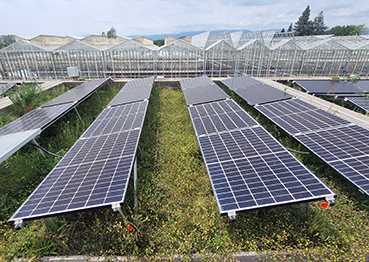

The PLANETE - Plants, Energy & Temperature project combines vegetated roofs and solar panels and compares the functioning of photovoltaic panels (of variable type and orientation) and the evolution of microclimate under these conditions.
This project is conducted in partnership with SIG, with the support of the Fonds Vitale Environnement and Innovation.
Context
At present, the share of solar energy in the Swiss electricity grid remains very low. In 2018, it represented 3.38% of the electricity demand (SFOE, 2019). To enable the deployment of solar photovoltaics, we need to increase the efficiency of production. To achieve this, we intend to combine the use of solar modules with roof greening. Indeed, the "overheating" of the solar modules reduces the electricity production; the vegetalization of the surface under the panels will limit this effect and lower temperatures due to shading and evapotranspiration.
The installation of photovoltaic modules, like the diversity of the substrates used, makes it possible to create varied environmental conditions (from full sun to mid-shade) that are favorable to native biodiversity, while contributing to energy production, and thus meeting energy, microclimatic and biodiversity challenges.
Objectives of the project
In view of the context previously presented, this research project aims to quantify:
Method
To meet these objectives, this project is conducting experiments quantifying the energy, biodiversity and microclimatic benefit by installing solar modules of different types and in different orientations on a substrate of local origin of varying thickness, sown with a mixture of native xerophilic seeds known for its specificity.
Results
From a climatic point of view, the combined installation of solar panels and extensive vegetation reduces average monthly temperatures at the roof surface by 3 to 7°C during heatwave periods, compared with a situation of full sunlight on untreated concrete. By comparison, the temperature reduction is only 2.5°C for solar panels without vegetation.
From an energy point of view, revegetation enables annual energy production to be maintained, or even slightly increased, by an average of +3%, due to the attenuation of summer heat peaks.
From a biological point of view, the spaced modules in a monopan arrangement offer plants and insects a whole range of shade and microclimates that encourage a greater diversity of species. They also encourage plants to thrive in autumn and winter, with a warming effect of +1 to +4°C linked to low-angled lighting.
Finally, a thick substrate also allows more water to be retained, which is desirable not only for the biodiversity of the roof, but also to temporarily buffer the intensity of rainfall in the event of a storm.


Project partner(s)
Project leader - team
Patrice Prunier
(HEPIA),
Ewa Renaud
(HEPIA),
Eric Amos
(HEPIA),
Pierre-André Frossard
(HEPIA),
Julie Steffen
(HEPIA),
Fabienne Mörch
(HEPIA)
